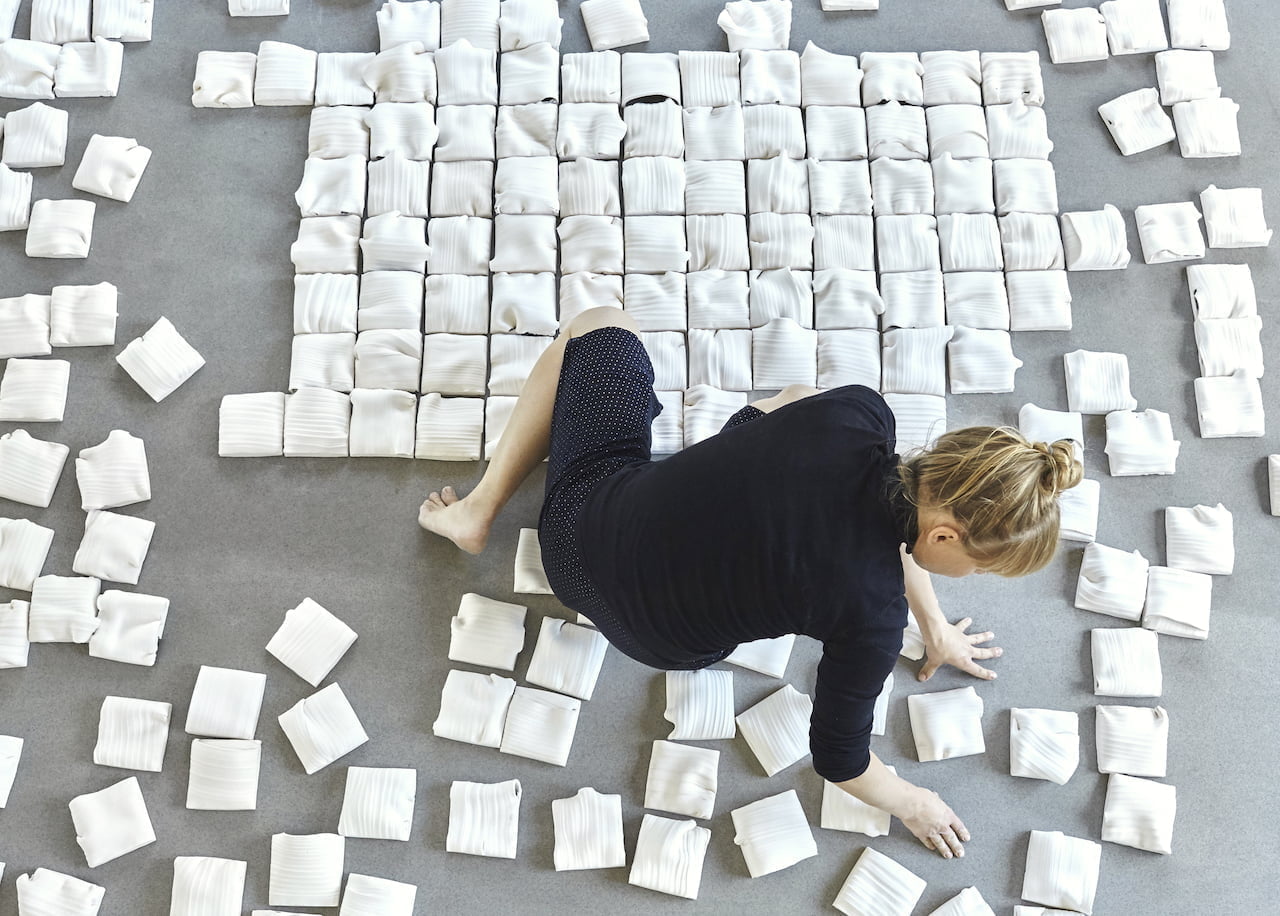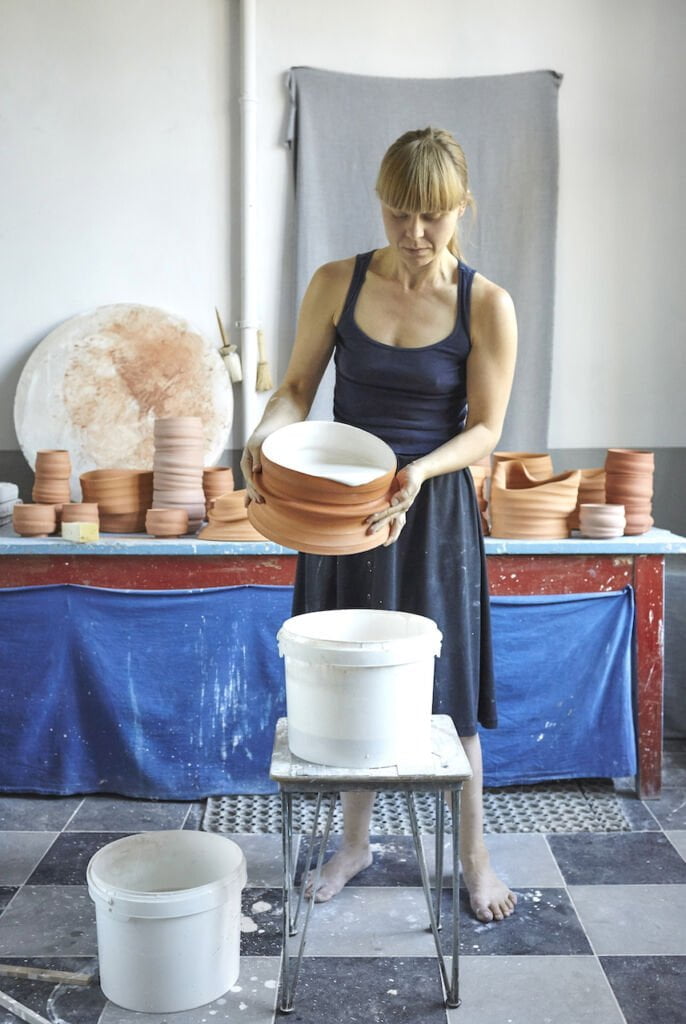Alicja Patanowska: The Body Leads Me Down a Winding Path
We invite you to the Dizajn BWA Wrocław gallery, where Alicja Patanowska will arrange a studio open to the public. For the first weeks of the project, she will be forming objects on a potter’s wheel, later to be displayed at the gallery as an exhibition.
Preparing material is the least esteemed but crucial stage. Admittedly, clay de-aeration machines are available nowadays, allowing an almost complete omission of the kneading phase, yet experiencing this physically exhausting process is still necessary. Thanks to it we learn first-hand how to recognize the perfect moisture and softness of the material. Also, clay formation enables us to prepare our muscles, tendons, wrists.
First, you must warm up your hands properly. Then you settle on the seat, assuming the optimum clay-shaping position. Place your buttocks on the stool comfortably. Steady your feet and pelvis, stiffen your thighs and belly. A bowl with water, sponge, cutting wire or string, perhaps also a scraper, are basic potter’s tools. A tool that you use thousands of times becomes an extension of your hand. For a skilful potter any kind of sponge or scraper will do. Using the tool is characterised by confidence and composure.
Centering is the most problematic stage of clay formation. At this point the rotation of the wheel is the fastest. The elevation and extension of a moist cone, followed by its flattening and pushing down, stirs the clay even further. It may lead to generating new, or releasing formerly hidden air bubbles. When I neutralize them I hear the characteristic, delicate and pleasant popping sound.
Trimming comes next. Using my fingers, I push out excess clay, which a minute later forms the raised walls. A stable body position is essential here, the elbows must rest on the thighs. Strength comes from the pelvis. Using hands alone in wheel throwing soon leads to wrist injuries.
Steady breathing and fluid movements play a crucial role in lifting the vessel walls. It is also the moment when your fingertips probe the thickness of the walls and clay moisture. They tell you how much longer and firmer we can continue to form the ware. I do the cutting off when the disk is still rotating. Everything here, from start to finish, is about a fluid, physical movement, in which I blend my body with the tool and material I work on. Just like any other craft, throwing on a potter’s wheel is choreography which everyone develops according to the capabilities of their own body, aptitude and way of working. A working body wears out. After days and days of wheel throwing the epidermis gets rubbed off. Due to exhaustion and lack of caution, your nails may be rubbed off too. In order to create a work, I must get slightly rubbed off physically, disappear a bit. I have to wane. To keep the balance.
– Alicja Patanowska

ABOUT THE PROJECT:
This spring, Alicja Patanowska – an artist, designer, potter – will arrange her studio at the Dizajn BWA Wrocław gallery. Over the first weeks, she will be throwing ware on a potter’s wheel, which she will then display in the form of a solo show there. The makeshift studio should seamlessly turn into an exhibition sometime around April. The switch may be abrupt, but it may as well stretch over weeks. It may even follow an unknown direction – this time we are not setting a strict deadline for the presentation but offer time and conditions necessary to carry out and watch an artistic process instead. We encourage you to become its part. Throughout the entire period, our gallery will be open during its regular hours, and the people helping you navigate through the experiment are discreet and empathetic. We will greet you in a warm, welcoming place. We will do our best to reconcile the artist’s needs with those of our audience, expecting something interesting for both sides to happen at their intersection.
The experiment responds to the precarious circumstances which often influenced the trajectories of Alicja’s project. After all, there is something liberating in succumbing to adversity and simply throwing oneself into work, whatever conditions it allows. We saw the great potential of this situation, revealing its implicit design and artistic aspect. It also aims to refocus attention from the subject to the process and conditions of its creation, as well as the very sense of creating subsequent objects in existing conditions resulting from inequalities in global production. The experiment may also develop new kinds of relationships with the audience and create a context for systematizing the documentation of other processes which Dizajn BWA Wrocław has been hosting since 2009. They were a peculiar element of the gallery’s programme for many years – when, instead of exhibitions, something was going on here for weeks on end. The results did not always make the visitors happy, but there were certain examples of processes which had exceptional value for all involved. Our experiment follows a demanding format which requires retuning the normal operations of the institution. However, it triggers a sense of agency and – something that Alicja Patanowska emphasizes – generates a social impact by going public. It is not only creating new objects, but also new relationships. This time we work with an artist who has been performing corporeality and processuality since the beginning of her practice. She says: My intention is depicting, even to the smallest extent, the overall activity of the body as a subject (or co-subject) generating knowledge through movement.
– Katarzyna Roj

Alicja Patanowska – artist, designer, graduate of Ceramics and Glass at the Royal College of Arts in London (2014) and Ceramics Design at the Eugeniusz Geppert Academy of Art and Design in Wrocław (2011), originator and organizer of the “Wytwórczo” new-crafts conference. Craftsmanship is essential in her artistic and design practice – she experiments with materials manually. Her response to the escalation of consumerist chaos is work based on personal commitment in the process of creating a product. Her trophies include the Franz Award (2019), Mazda Design Award (2018), British Glass Biennale (2015). Her works feature in art and design collections, including the Shanghai Museum of Glass, as well as e.g. Merci (Paris), Deutsche Bank Kunsthalle (Berlin), Barbican Centre and Tate Modern (London). She took part in over a hundred exhibitions around the world, including Britain, Denmark, Ireland, Korea, Germany, Azerbaijan, Sweden, Finland, China, Brazil. She is keen on barter.
Curator: Katarzyna Roj
Texts: Alicja Patanowska, Ewa Klekot
Visual communication: Grupa PROJEKTOR
Media patronage: Notes Na 6 Tygodni
Production: Monika Marciniak
WCo-operation with audience: Klementyna Epa, Magdalena Weber